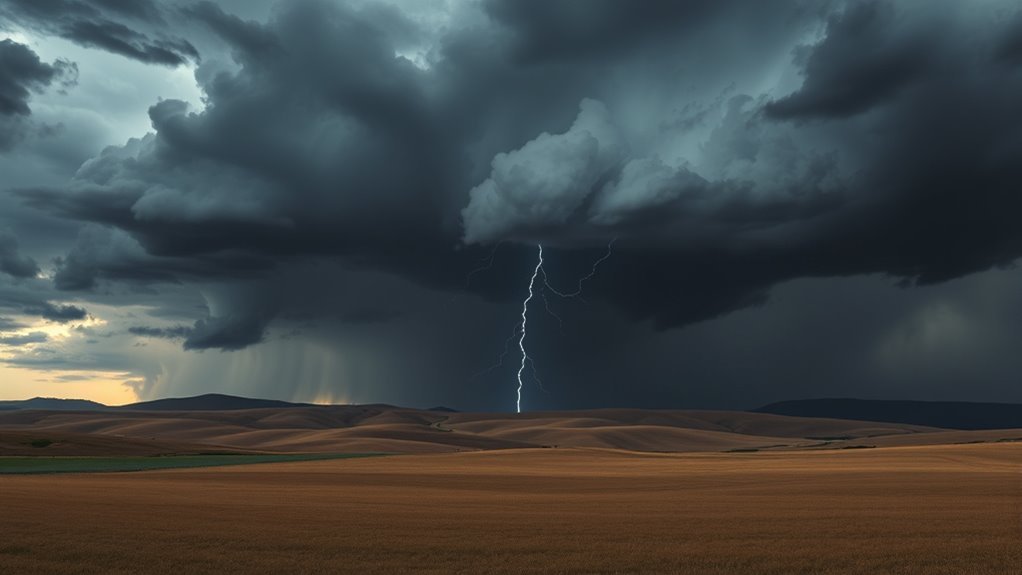Weather models are essential for predicting squalls by simulating atmospheric behavior using advanced algorithms and real-time data from various sources. These models can capture key factors such as instability and wind shear that contribute to squall formation. Despite their strengths, limitations in data resolution and the complexity of atmospheric interactions can hinder accurate forecasts. Innovations in technology and machine learning are improving these models. Further exploration reveals additional advancements and future directions for enhancing squall prediction accuracy.
Main Points
- Weather models utilize mathematical simulations and data from various sources to predict atmospheric phenomena, including squalls.
- Squalls are difficult to forecast due to limitations in data resolution and the complexity of atmospheric interactions.
- Advanced data assimilation techniques and high-resolution forecasting improve model accuracy and detail in squall predictions.
- Machine learning enhances weather modeling by analyzing large datasets and identifying patterns that traditional methods may overlook.
- Collaborative research initiatives and public-private partnerships aim to enhance squall prediction accuracy through improved data sharing and technology integration.
Understanding Weather Models: An Overview
Weather models play a crucial role in predicting atmospheric phenomena, including the formation of squalls. These computational tools utilize a set of mathematical equations to simulate the behavior of the atmosphere. By integrating data from various sources—such as satellite observations, weather stations, and radar—models can generate forecasts that help meteorologists understand weather patterns and potential disruptions.
Different types of weather models exist, ranging from global to regional scales, each offering varying levels of detail and accuracy. Global models provide broad coverage and insight into large-scale weather patterns, while regional models focus on specific areas, offering higher resolution and improved predictions for localized events.
Ultimately, the effectiveness of weather models lies in their ability to process extensive amounts of data, enabling meteorologists to anticipate changes in the atmosphere with increasing precision. Consequently, these models are indispensable tools in modern meteorology, particularly in forecasting severe weather conditions.
The Science Behind Squall Formation

Understanding the mechanics of squall formation involves examining the interplay of atmospheric conditions that lead to these sudden and intense weather events. Squalls typically arise from the interaction of warm, moist air at the surface and cooler, drier air aloft. This convergence often creates instability in the atmosphere, triggering rapid upward motion.
As the warm air ascends, it cools and condenses, forming cumulonimbus clouds, which are capable of producing heavy precipitation and strong winds.
Additionally, wind shear, or the change in wind speed and direction with altitude, plays a critical role in enhancing the development of squalls. This shear can contribute to the organization of storms, leading to the formation of squall lines.
The combination of these factors culminates in the sudden onset of severe weather, making squall formation a complex but fascinating phenomenon that exemplifies the dynamic nature of the atmosphere.
Key Features of Modern Weather Models
Modern weather models incorporate advanced data assimilation techniques that improve the accuracy of forecasts.
High-resolution spatial forecasting allows for detailed predictions at localized levels, enhancing the understanding of phenomena like squalls.
Additionally, real-time simulation models enable meteorologists to observe evolving weather patterns more effectively, facilitating timely warnings and responses.
Advanced Data Assimilation Techniques
As atmospheric conditions fluctuate, advanced data assimilation techniques play an essential role in enhancing the accuracy of weather models. These techniques enable meteorologists to combine observational data with model predictions, resulting in improved forecasts.
Key features of these methods include:
- Real-time Data Integration: Incorporating live observations from various sources, such as satellites and weather stations.
- Ensemble Forecasting: Utilizing multiple model simulations to account for uncertainties and improve predictive reliability.
- Kalman Filtering: Applying mathematical algorithms to update model states based on new data, ensuring continuous refinement.
- Variational Methods: Optimizing model parameters by minimizing differences between observed and simulated data.
Through these sophisticated techniques, weather models can more accurately predict phenomena like squalls, eventually benefiting public safety and preparedness.
High-Resolution Spatial Forecasting
While traditional weather models often relied on broader spatial resolutions, high-resolution spatial forecasting has transformed meteorological predictions by offering greater detail and accuracy.
These modern models utilize finer grid spacing, enabling meteorologists to capture smaller-scale phenomena, such as localized squall formations. The implementation of high-resolution forecasting promotes a more subtle understanding of atmospheric dynamics, leading to improved prediction of severe weather events.
Additionally, these models incorporate advanced observational data, enhancing their ability to resolve complex patterns associated with storm development. By integrating sophisticated algorithms and computing power, high-resolution spatial forecasting minimizes errors and increases reliability, ultimately assisting in timely alerts and proactive measures.
This evolution in weather modeling represents a considerable leap forward in the pursuit of precise meteorological forecasting.
Real-Time Simulation Models
The advancement of high-resolution spatial forecasting has paved the way for the development of real-time simulation models, which are essential in enhancing weather prediction capabilities.
These models utilize state-of-the-art technology and algorithms to provide timely and accurate forecasts, particularly for squall formation.
Key features of modern real-time simulation models include:
- High Temporal Resolution: Allows for minute-by-minute updates, capturing rapid changes in weather conditions.
- Data Assimilation Techniques: Integrates real-time observational data to refine model accuracy.
- Advanced Physics-Based Simulations: Utilizes sophisticated atmospheric physics to simulate complex weather phenomena.
- User-Friendly Interfaces: Provides accessible tools for meteorologists and researchers to analyze and interpret data effectively.
These features greatly improve the reliability of weather forecasts, especially for severe weather events.
Strengths of Weather Models in Squall Prediction

Weather models play an important role in predicting squall formation, providing meteorologists with valuable viewpoints into atmospheric conditions. These models utilize complex algorithms to simulate and analyze a multitude of variables, including temperature, humidity, wind patterns, and pressure changes.
By integrating real-time data from satellites and weather stations, they offer an extensive view of evolving weather systems.
One of the key strengths of weather models is their ability to identify critical thresholds that precede squall events. They can detect moisture convergence and instability in the atmosphere, which are essential indicators of potential squall formation.
Additionally, advancements in numerical weather prediction techniques have improved the accuracy of short-term forecasts, allowing for timely alerts to be issued.
Limitations and Challenges in Forecasting Squalls

Despite the advancements in weather models, considerable limitations and challenges remain in forecasting squalls. These challenges hinder the ability of meteorologists to provide accurate and timely warnings, thereby affecting safety and preparedness.
Key limitations include:
- Data Resolution: Many models operate at coarse resolutions, which fail to capture small-scale features critical for squall formation.
- Initial Conditions: The accuracy of forecasts heavily relies on the quality of initial atmospheric conditions, which can be poorly represented.
- Complex Interactions: Squalls often arise from complex interactions between various atmospheric phenomena, making them difficult to predict.
- Model Limitations: Existing models may not account for all physical processes involved in squall formation, leading to incomplete predictions.
These factors contribute to the ongoing challenge of accurately forecasting squalls, emphasizing the need for continued advancements in meteorological modeling techniques.
Recent Advances in Weather Modeling Technology
As meteorologists continue to confront the challenges of squall forecasting, recent advances in weather modeling technology have emerged as essential tools in improving prediction accuracy.
Innovations in computational power have allowed for higher-resolution models that capture small-scale atmospheric phenomena more effectively. These models utilize advanced algorithms and machine learning techniques to analyze extensive datasets, enhancing the detection of conditions conducive to squall formation.
Moreover, the integration of satellite and radar data into modeling frameworks has made possible real-time updates, allowing forecasters to adjust predictions dynamically. Improved data assimilation techniques have also contributed to refining model outputs, enabling more accurate simulations of storm development.
The implementation of ensemble forecasting methods further helps in evaluating uncertainty, providing a range of possible outcomes rather than a single prediction.
Collectively, these technological advancements are notably improving the reliability of squall forecasts, helping meteorologists better serve communities at risk from severe weather events.
Future Directions for Improved Squall Prediction
Future advancements in squall prediction will likely focus on improved data collection techniques to boost the accuracy of weather models.
Additionally, the integration of advanced machine learning algorithms could considerably refine predictive capabilities.
Collaborative research initiatives will also play an essential role in encouraging innovation and sharing knowledge across the meteorological community.
Enhanced Data Collection Techniques
Improved data collection techniques represent a vital advancement in the quest for accurate squall prediction. Improved methods promote the gathering of essential atmospheric data, leading to better forecasting outcomes.
The following techniques are particularly noteworthy:
- Remote Sensing: Utilization of satellites and radar to monitor weather patterns in real-time.
- Unmanned Aerial Vehicles (UAVs): Deployment of drones to collect data from hard-to-reach areas, improving spatial coverage.
- Crowdsourced Weather Data: Engaging the public to report local weather conditions, enriching dataset variety.
- Advanced Ground Stations: Installation of high-precision weather stations to capture minute changes in meteorological variables.
Together, these methods improve the reliability of squall predictions, enabling meteorologists to respond more effectively to severe weather events.
Advanced Machine Learning Algorithms
Harnessing advanced machine learning algorithms opens new avenues for improving squall prediction accuracy.
These algorithms can analyze extensive datasets from various sources, including satellite imagery and weather sensor data, to identify patterns that traditional models may overlook. Techniques such as deep learning and ensemble methods increase the ability to predict squall formation by refining the classification of meteorological conditions.
Furthermore, machine learning can adjust in real-time, continuously learning from new data inputs, which boosts its predictive capabilities. By integrating these algorithms into existing weather models, meteorologists can achieve a more intricate understanding of squall dynamics.
This innovation represents a notable step forward, promising to improve the reliability of forecasts and finally bolster safety measures for affected regions.
Collaborative Research Initiatives
As researchers acknowledge the limitations of individual forecasting models, collaborative research initiatives are emerging as a critical strategy for enhancing squall prediction.
By pooling resources and knowledge, these initiatives aim to create more robust forecasting systems. Key components of these collaborative efforts include:
- Data Sharing: Allowing access to diverse datasets from various meteorological institutions.
- Interdisciplinary Collaboration: Involving experts from meteorology, computer science, and environmental science to develop cutting-edge models.
- Standardized Protocols: Establishing common methodologies for model validation and performance assessment.
- Public-Private Partnerships: Engaging both governmental and commercial entities to utilize technological advancements.
Through these strategies, researchers hope to improve the accuracy and timeliness of squall predictions, in the end enhancing public safety and preparedness.
Common Questions
How Do Meteorologists Verify Model Predictions for Squall Formation?
Meteorologists verify model predictions for squall formation by comparing simulated data against real-time observations. They analyze radar imagery, satellite data, and surface reports to assess the accuracy of forecasts and refine future modeling techniques.
What Tools Do Meteorologists Use Alongside Weather Models?
Meteorologists utilize various tools alongside weather models, including radar systems for real-time observation, satellite imagery for cloud patterns, and weather stations for localized data. These instruments improve their understanding and predictions of atmospheric conditions.
How Accurate Are Weather Models in Different Geographical Areas?
The accuracy of weather models varies considerably across geographical areas due to factors like topography, climate, and data availability. Some regions benefit from advanced modeling techniques, while others face challenges that reduce predictive reliability.
Can Squalls Form Unexpectedly Despite Model Predictions?
Unexpected squalls can indeed develop, even when models suggest otherwise. Factors such as localized atmospheric conditions and rapid changes in temperature or humidity may lead to sudden squall formation, highlighting the limitations of predictive models.
What Role Do Satellite Data Play in Weather Modeling?
Satellite data serve an essential role in weather modeling by providing real-time observations of atmospheric conditions. This information improves model accuracy, allowing meteorologists to refine predictions and enhance understanding of complex weather phenomena and their developments.

